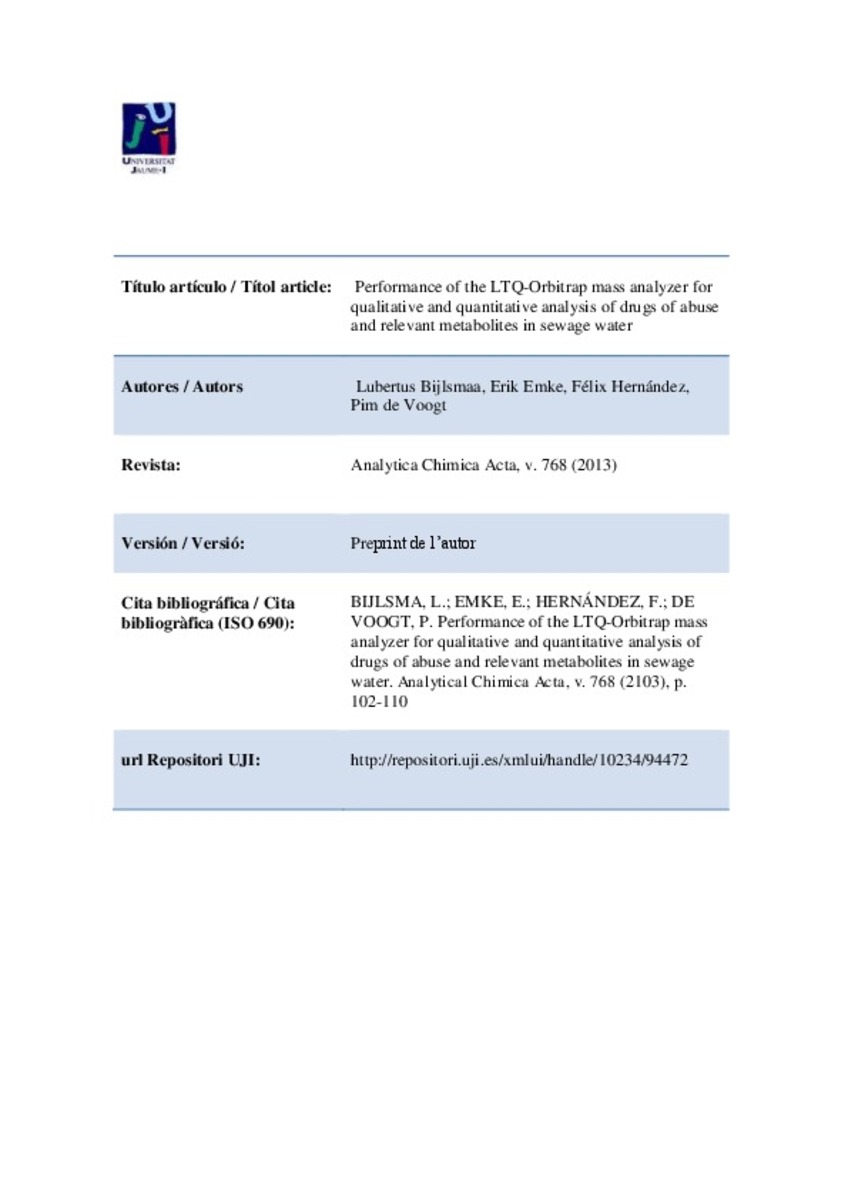Mostrar el registro sencillo del ítem
Performance of the linear ion trap Orbitrap mass analyzer for qualitative and quantitative analysis of drugs of abuse and relevant metabolites in sewage water
| dc.contributor.author | Bijlsma, Lubertus | |
| dc.contributor.author | Emke, Erik | |
| dc.contributor.author | Hernandez, Felix | |
| dc.contributor.author | de Voogt, Pim | |
| dc.date.accessioned | 2014-06-06T07:32:25Z | |
| dc.date.available | 2014-06-06T07:32:25Z | |
| dc.date.issued | 2013-03-20 | |
| dc.identifier.citation | BIJLSMA, L.; EMKE, E.; HERNÁNDEZ, F.; DE VOOGT, P. Performance of the LTQ-Orbitrap mass analyzer for qualitative and quantitative analysis of drugs of abuse and relevant metabolites in sewage water. Analytical Chimica Acta, v. 768 (2103), p. 102-110 | ca_CA |
| dc.identifier.uri | http://hdl.handle.net/10234/94472 | |
| dc.description.abstract | This work illustrates the potential of liquid chromatography coupled to a hybrid linear ion trap Fourier Transform Orbitrap mass spectrometer for the simultaneous identification and quantification of 24 drugs of abuse and relevant metabolites in sewage water. The developed methodology consisted of automatic solid-phase extraction using Oasis HLB cartridges, chromatographic separation of the targeted drugs, full-scan accurate mass data acquisition under positive electrospray ionization mode over an m/z range of 50–600 Da at a resolution of 30,000 FWHM and simultaneous MSn measurements to obtain information of fragment ions generated in the linear ion trap. Accurate mass of the protonated molecule, together with at least one nominal mass product ion and retention time allowed the confident identification of the compounds detected in these complex matrices. In addition to the highly reliable qualitative analysis, Orbitrap analyzer also proved to have satisfactory potential for quantification at sub-ppb analyte levels, a possibility that has been very little explored in the literature until now. The limits of quantification ranged from 4 to 68 ng L−1 in influent sewage water, and from 2 to 35 ng L−1 in effluent, with the exception of MDA, morphine and THC that presented higher values as a consequence of the high ionization suppression in this type of samples. Satisfactory recoveries (70–120%) and precision (<30%) for the overall procedure were obtained for all compounds with the exception of meta-chlorophenylpiperazine, methylphenidate and ketamine. Isotope-labelled internal standards were added to sewage samples as surrogates in order to correct for matrix effects and also for possible losses during sample treatment. The methodology developed was applied to sewage water samples from the Netherlands (influent and effluent), and the results were compared with those obtained by LC–MS/MS with triple quadrupole. Several drugs of abuse could be identified and quantified, mainly MDMA, benzoylecgonine, codeine, oxazepam and temazepam. Orbitrap also showed potential for retrospective investigation of ketamine metabolites in the samples without the need of additional analysis. | ca_CA |
| dc.format.extent | 27 p. | ca_CA |
| dc.format.mimetype | application/pdf | ca_CA |
| dc.language.iso | eng | ca_CA |
| dc.publisher | Elsevier | ca_CA |
| dc.relation.isPartOf | Analytica Chimica Acta, v. 768 (2013) | ca_CA |
| dc.rights.uri | http://rightsstatements.org/vocab/CNE/1.0/ | * |
| dc.subject | Drugs of abuse | ca_CA |
| dc.subject | Accurate mass | ca_CA |
| dc.subject | Orbitrap analyzer | ca_CA |
| dc.subject | High resolution mass spectrometry | ca_CA |
| dc.subject | Quantitative analysis | ca_CA |
| dc.subject | Sewage water | ca_CA |
| dc.title | Performance of the linear ion trap Orbitrap mass analyzer for qualitative and quantitative analysis of drugs of abuse and relevant metabolites in sewage water | ca_CA |
| dc.type | info:eu-repo/semantics/article | ca_CA |
| dc.identifier.doi | http://dx.doi.org/10.1016/j.aca.2013.01.010 | |
| dc.rights.accessRights | info:eu-repo/semantics/openAccess | ca_CA |
| dc.relation.publisherVersion | http://www.sciencedirect.com/science/article/pii/S0003267013001190 | ca_CA |
| dc.edition | Preprint | ca_CA |
| dc.type.version | info:eu-repo/semantics/submittedVersion | |
| dc.type.version | info:eu-repo/semantics/submittedVersion | ca_CA |
Ficheros en el ítem
Este ítem aparece en la(s) siguiente(s) colección(ones)
-
IUPA_Articles [306]
-
QFA_Articles [813]
Articles de publicacions periòdiques







